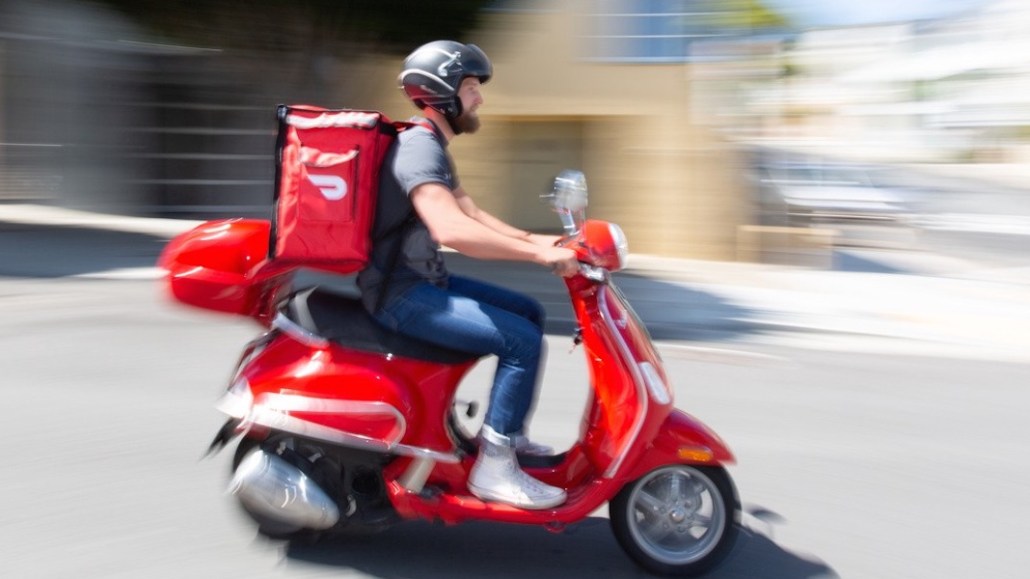
Restaurant delivery service DoorDash is expanding its reach to last-mile delivery for physical retail.
The 6-year-old company, which reportedly raised $500 million at a $6 billion valuation this week, acts a courier for 300,000 restaurants in Canada and the U.S., fulfilling online orders. But as retailers look to shorten delivery windows and figure out online order fulfillment from physical stores, DoorDash sees an opportunity. It first stepped into retail delivery with a grocery delivery partnership with Walmart that went live last April and the company is pointing to its 30-minute delivery windows and insight into customer data as part of its pitch to retailers.
“Every product that we consume will most likely be delivered at some point in our lives in two hours or less; the first manifestation of that is food,” said Toby Espinosa, head of business development at DoorDash. “Our Drive [enterprise] platform enables us to make deliveries on behalf of partners that aren’t necessarily food or restaurants, and that’s where we see our entry into new verticals like grocery or retail.”
DoorDash has two sides to its business: One is its consumer-facing marketplace, which connects consumers to participating brands through the DoorDash app. The other is Drive, which is DoorDash’s platform for working with retailers that launched in 2016. Like Postmates, which delivers a range of consumer goods beyond groceries, DoorDash has begun moving into consumer retail beginning with its tie-up with Walmart, and has ambitions to expand to new areas like alcohol delivery. DoorDash lets retailers embed its technology into its digital ordering platforms that connect directly to the DoorDash fleet, which Postmates also offers.
DoorDash also offers retailers capabilities to understand customer behavior based on insights from Drive as well as its consumer-facing platform, including which products tend to be ordered at specific times of the day and neighborhood insights. It also offers brands operational insights, such as what delivery times are optimal. Brands can use the insights they get from Drive to figure out decisions like where to launch new locations, whether to raise delivery fees during peak service times, and prompt time-of-day based promotions to encourage orders.
DoorDash is up against a crowded field of competitors as retailers figure out last-mile delivery solutions. Other services like Postmates (which recently filed for an IPO), Uber Eats, Deliv, Instacart and Deliverr all vying for market share. Meanwhile, GrubHub is the market leader on food delivery. Despite the competition, DoorDash’s pitch to retailers includes breadth of its “Dasher” delivery driver fleet (it operates in all 50 states and several Canadian cities), customer experience (the ability to customize elements of the delivery process depending on a brand’s requirements) and direct point-of-sale integration.
“DoorDash, in particular, appears to be working to advance the data that they can provide to partnered restaurants,” said Gartner analyst Evan Mack. “Chipotle’s site features DoorDash integration that allows the restaurant to have DoorDash deliver orders while maintaining access to live order updates, customer feedback, and localized delivery information.”
Similarly, Wendy’s, in a recent earnings call, reported that DoorDash integration gives them a better understanding of customer behavior.
“We’re partnering with DoorDash to have the access to the [customer] data and to share information,” Wendy’s CEO Todd Penegor said in an earnings call last August. “We’re working to integrate DoorDash into our app some time into the future in partnership with them. We’ve always talked about having the customer — from the time they order to the time that it’s delivered, optimal is under 30 minutes. ”
As the delivery field gets more competitive, companies will face increasing pressure to differentiate and maintain the same level of service across different business areas — be it restaurants, consumer-packaged goods or groceries. Retailers may also show a degree of risk aversion by experimenting with multiple platforms, as Walmart has done, working with Point Pickup, Skipcart, AxleHire and Roadie and Deliverr (Walmart earlier experimented with Uber and Lyft, before abandoning these programs). Maintaining a consistent service experience will be the key challenge, said Jonathan Smalley, CEO of data analytics company Yaguara.
“It will be interesting to see if they can keep [the same customer experience] when expanding beyond restaurants into other types of retail,” he said. “The delivery experience can be really hard to control, especially given that a lot of couriers are working for multiple platforms.”
More in Marketing

Lowe’s wants to do more with AI shopping in 2026
Mylow, a shopping assistant powered by ChatGPT that launched in March, is already driving double the conversion rate for online shoppers.

‘This isn’t the old pre-roll world’: YouTube has been talking TV — now it’s selling that way
YouTube is ramping up efforts to get TV’s largest advertisers to move more of their budget into its platform.

As every screen becomes shoppable, attribution problems resurface
As more media environments become points of purchase, attribution and measurement remain the thorn in the side of commerce execs.





